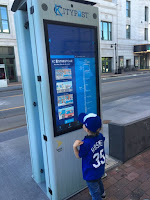Union Station master planning public meeting this Thursday (and an example of digital information kiosks delivering public meeting notices and related information)
I've seen ads in the Express for this upcoming meeting, Thursday 3/22 at 4pm.
-- Union Station Expansion Planning Project, Federal Railroad Administration
I did submit comments in the last go around. This piece referenced best practice station planning resources ("DC Union Station EIS FRA -- Comments due November 9th") and suggested leveraging the federal ownership of Union Station and making it a North American flagship in terms of integrating sustainable modes into the station, and "undergrounding" off from the plaza in front of the station the various car pick up and drop off services, and some surface transit.
It will be interesting to see whether or not these ideas made it into the next stage of the planning process.

I was surprised yesterday to see a public notice for the meeting displayed on the advertising-directory kiosks in Union Station.
It's a perfect example of what I argue for in the creation of a "public events and programs" advertising stream to be embedded within public kiosk systems.
Below is a reprint of the section from the Silver Spring pieces ("PL #5: Creating a Silver Spring "Sustainable Mobility District" | Part 3: Program items 10-18," where I outline how such a system could work.
Create a digital community and transit information network [for Silver Spring,] employing kiosks and mobile applications. For at least 15 years, I've been thinking about how to create and deliver a city- (county-) wide digital nonprofit and cultural communications feed, with sub-feeds for neighborhoods/districts.
Now, with real-time transit information feeds like TransitScreen, you can use them as the engine but add other feeds to the engine. That's how the digital information kiosks work (called CityPost, produced by Smart City Media) alongside the Kansas City Streetcar.
From the Digital Signage Today article "Meridian deploys outdoor interactive kiosks in Kansas City" :
The interactive kiosks, located at Kansas City Streetcar platforms and throughout downtown, enable travelers to check the arrival time of the next streetcar, offer Kansas City locals and tourists access to city services, and display information about local restaurants, activities and events...There is also the LinkNYC program, delivered by Civiq Smartscapes, but these systems tend to be more focused on delivering advertising rather than useful community-specific information. I have similar concerns about a program done separately by the New York MTA transit agencies, with placement of kiosks on station platforms.
Kiosk users can sync their smartphones to the kiosk with a mobile app to save and share information. For example, Kansas City Streetcar travelers might see an ad for dinner at a local restaurant. They are then able to pull that information onto their mobile device to access again at their convenience.
The feed would be multi-stream instead of a single advertising feed or a single transit information feed.
Take (1) the digital ad feed presented in bus shelters and transit stations; (2) add transit and mobility information like the TransitScreen application; and (3) create and deliver a separate "community information feed" promoting nonprofit and public sector organization, events, public meeting notices, etc. (Note that Outfront Media is doing (1) and (2) on screens in Metrorail stations.)
There is great need for systematically delivering community information in public and visible ways in many places, because community media outlets are going out of business because of how the Internet has changed the business of media and advertising.
In fact, Montgomery County does a form of delivering community information digitally at the Silver Spring Civic Center, where they have two digital screens side-by-side behind the information desk. One presents the TransitScreen info, and the other cycles through "ads" for Montgomery County Government agencies and services, and community events.
The idea is to create content in a way that works at two scales: (1) a city or county; and (2) at the sub-city/county scale, by neighborhood/ transit district.
The stream would be device independent, so that it could be displayed on screens and kiosks as well as received on a digital feed. Besides delivering this digital network in kiosks at transit stations and key "crossroads," in bus shelters, and civic buildings and sites, ideally, places like coffee shops, office and apartment buildings, etc., would put up screens and "subscribe" to the feed as a service to their customers/tenants--many do this with transit information already.
As another example, recently I came across the Pitt Smart Living Project, but it seems to focus only on delivering area-specific transit information.
-- Pitt Smart Living Project TransitScreen for Sennott Square
To create and deliver the community ads and event content, I'd set up an "advertising and design curriculum" as part of the School of Art and Design at Montgomery College, perhaps with the involvement of the journalism program of Montgomery-Blair High School, which very actively markets its Silver Chips student newspaper to the community beyond the school.
A way to extend the community and educational value of the program would be to create an equivalent of the teen graphic design program of Boston's Artists for Humanity. Arts on the Block, based in Kensington, could participate too. The firm handling advertising in Montgomery County's bus shelters would be another partner.
Currently the MC Media Arts & Technology program is located at the Rockville campus,
-- Smart City Media video showing the program in Kansas City
An issue is whether or not to include "for profit" ads. I would in part to defray costs, but outside of bus shelters, perhaps ads should be limited to businesses based in Silver Spring, potentially the Silver Spring retail trade area (which includes parts of DC and arguably, part of Prince George's County), and Montgomery County outside of Silver Spring.
Labels: community information systems, land use planning, railroads, real estate development, station area planning, transportation infrastructure, transportation planning, urban design/placemaking




1 Comments:
passenger station screens in Chicago:
http://www.govtech.com/fs/transportation/Digital-Advertising-Takes-a-Useful-Turn-for-Chicago-Transit-Riders.html
https://www.curbed.com/2018/3/14/17122000/smart-city-advertising-subway
Post a Comment
<< Home